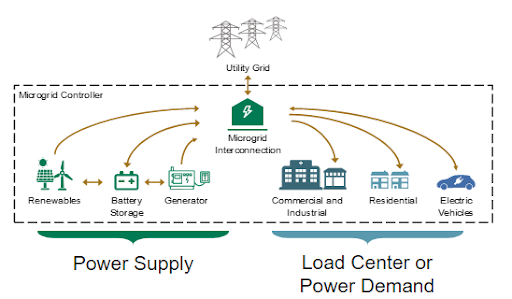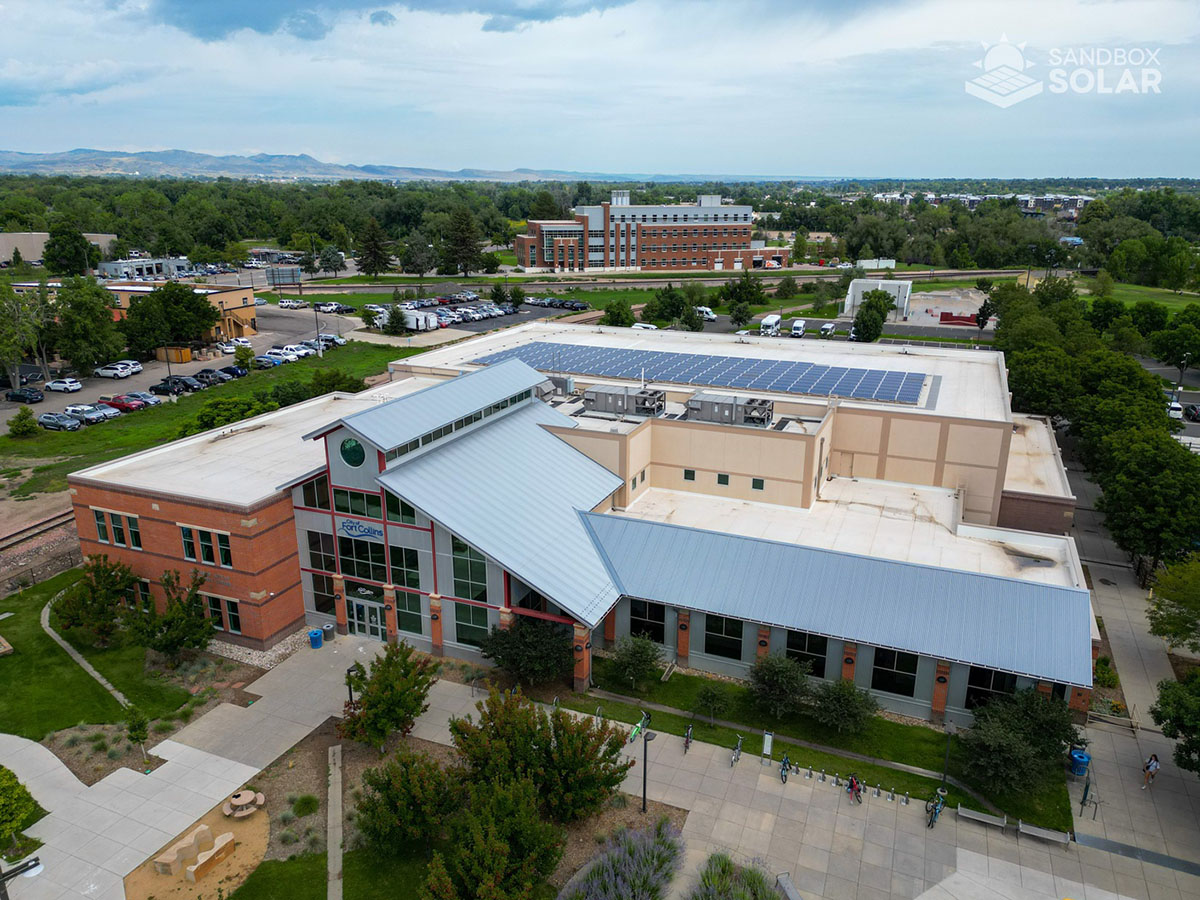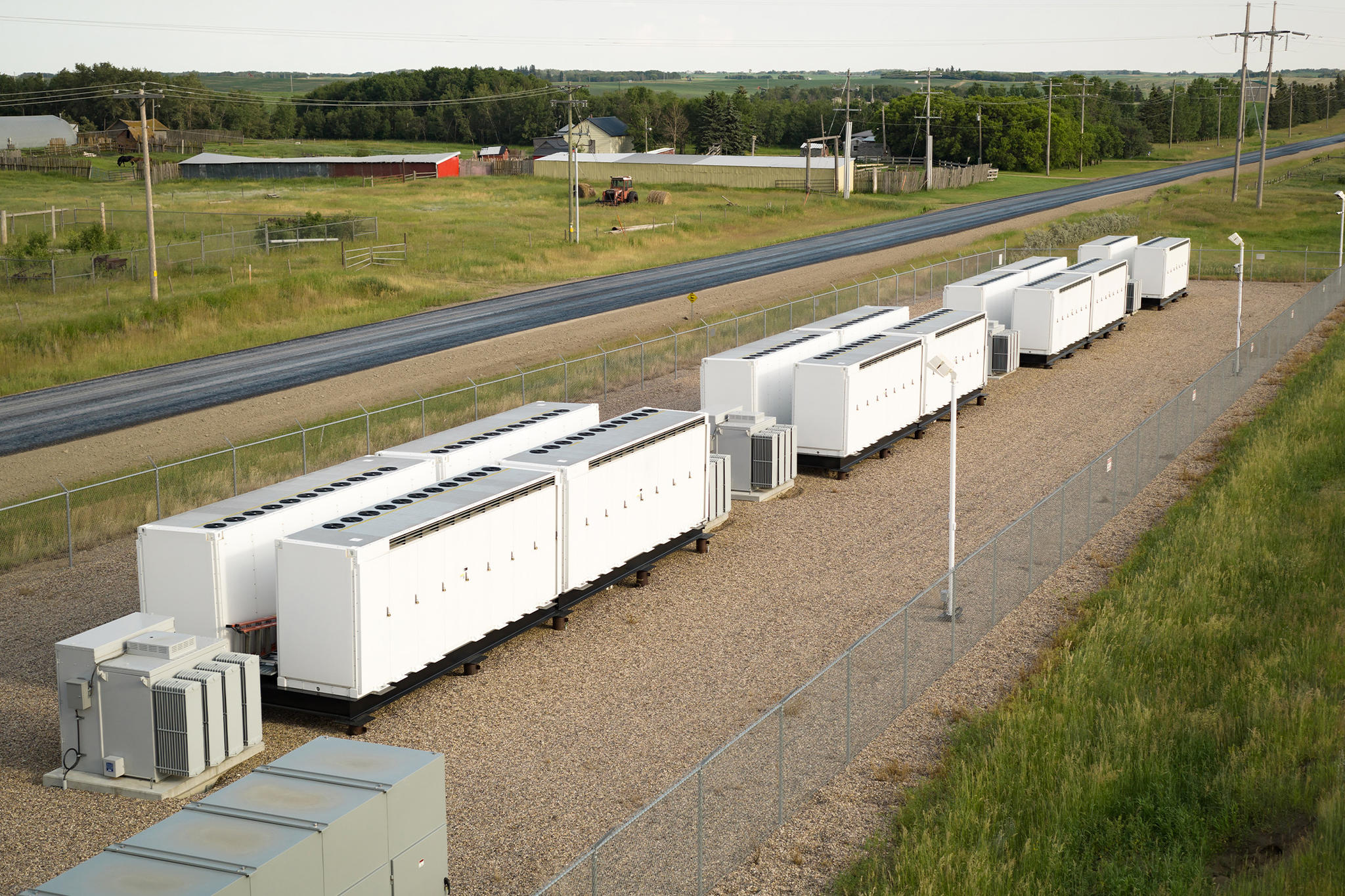Energy Resilience: Three Levels of Microgrids Across Larimer County
The Takeaways
- Various sizes and scales of microgrids have been developed around Colorado. Microgrids provide efficient, low-cost, and clean energy, enhance local resiliency, and improve reliability of the regional electric grid. For more information, visit our Microgrids 101 webpage.
- Rural and isolated communities can benefit from microgrids as an alternative to expanding and protecting power transmission lines, which can be expensive and challenging given mountainous and expansive terrain.

Credit: NORESCO
The Department of Energy (DOE) defines a microgrid as ‘‘a group of interconnected loads and distributed energy resources within clearly defined electrical boundaries that acts as a single controllable entity with respect to the grid. A microgrid can connect and disconnect from the grid to enable it to operate in both grid-connected or island mode.’’ As can be seen in the above image, the power supply (including renewables, battery storage, and generator) and power demand (including loads such as electric vehicles, residential, commercial, and industrial buildings) are managed by a microgrid controller, which interconnects at a single point to the utility grid.
Microgrids come in many forms and can be categorized in many ways such as:
- Size (small or large);
- Types of distributed energy resources (renewable or conventional); and
- Customer type (federal, residential, commercial, or industrial)
Three “levels” of microgrids provide a helpful categorization to portray the size, scope, and management of a microgrid. Microgrids can range in size from a single building or customer ( “Level 1” microgrids) to multiple buildings from a single customer (“Level 2” microgrids) or an entire community or distribution feeder line (“Level 3” microgrids). Level 1 and 2 microgrids are both “behind the meter”, or located on the customer’s property, whereas Level 3 microgrids are “in front of the meter”, on the utility side of the electrical grid.
Various utilities and partners in Larimer County are developing microgrids across these levels with funding from the Department of Local Affairs (DOLA), as described below.
Level 1 “Single Building Microgrid” in Fort Collins
A Level 1 microgrid includes a single distributed energy resource (DER) system that serves a single building interconnected to the grid at a single utility meter location.
An example of an existing Level 1 microgrid is the Northside Community Center in Fort Collins, with funding from the DOLA Energy/Mineral Impact Assistance Fund (2020). The Northside Aztlan Community Center is a LEED Gold, net zero recreation center located near disproportionately impacted populations. The landscaping includes an urban tree canopy to help provide shade and cooling to reduce the urban heat island effect.
The power supply/DER system for the Aztlan Center microgrid comes from a 174 kW solar photovoltaic (PV) system that is connected to 120 kW of battery storage. The City of Fort Collins and their municipal utility partnered to design this microgrid in order to provide backup power during the fire season, therefore enabling the Center to host base operations for first responders. During normal, non-emergency operations, the Aztlan Center microgrid will provide “demand response services,” which means that during times of peak energy demand, the utility can pull energy from the Aztlan Center battery storage system. This stabilizes the electric grid, provides cost benefits to the City of Fort Collins who can sell the energy back to the utility, and reduces the need for the utility to build out more energy resources for peak demand periods. The microgrid is providing a test case for operations and benefits. For example, the utility is analyzing how well it can control the batteries remotely and how to best integrate the microgrid software in order to optimize the usage of the battery storage and its benefits.
Level 2 “Partial Feeder” or “Campus Microgrid” in Livermore
A Level 2 microgrid includes either a single or multiple DER system serving multiple buildings, interconnected to the grid at a single utility meter location. Level 2 microgrids can island whole campuses or partial feeders from the distribution grid. A feeder is an electrical line from a utility substation, serving customers within a defined local distribution area. Examples of this classification are a campus setting such as a college or university, healthcare/hospital campus, pharmaceutical complex, or military base.
An example of a Level 2 microgrid is the Poudre Valley Rural Electric Association Livermore Microgrid, which is partially funded by the DOLA Microgrids for Community Resilience (MCR) Program. The remote community of Livermore is subject to a variety of natural disasters, most notably wildfires and snow blizzards. These major weather events often render the highway in and out of the community impassable, cutting Livermore and the surrounding residences off from the outside world. Without expanding transmission lines, a community-wide microgrid emerged as a cost effective alternative.
The power supply/DER system for the Livermore microgrid comes from a 70 kW solar PV array that’s connected to a 350 kW battery installed at the Livermore Fire Station. The Level 2 microgrid offers the entire community of Livermore access to resilient energy supply, in addition to critical facilities such as fire station, CDOT facility, a retail store, restaurant, school, post office, gas station, and more.
Level 3 “Full Feeder” or “Community Microgrid” in Estes Park
A Level 3 microgrid includes a single or multiple DER system serving multiple buildings or customers, however the loads and generation sources may not be interconnected at the same utility meter location. Instead, these advanced microgrids will have one point of common coupling (PCC), where the microgrid can be operated independently from the utility grid. The individual buildings or customers may be independently connected to the larger distribution grid and through the microgrid PCC and some customers may even have Level 1 or Level 2 microgrids that support the operation of the community microgrid.
the larger distribution grid and through the microgrid PCC and some customers may even have Level 1 or Level 2 microgrids that support the operation of the community microgrid.
An example of a Level 3 microgrid that is currently under development is the Platte River Power Authority (PRPA), Estes Park Microgrid, which is partially funded by the MCR Program and highlighted in a Department of Energy video. The PRPA utility is leasing a 5 MW (20 MWh) battery on a feeder line in Estes Park, CO that serves 4 critical loads: the utility shop, Estes Valley Protection District, Estes Emergency Response Command Center, and Estes Park Hospital. The approach of leasing a battery asset – versus owning the asset outright – is a new approach that reduces the utility’s risks and involvement in the operations of the microgrid. This project will offer an alternative to expanding transmission lines over challenging and mountainous terrain.
The battery will serve many benefits to the PRPA and Estes Park community, including:
- Ensuring power to critical loads when the town is isolated from the main grid
- Reducing impacts on utility infrastructure during peak load
- Addressing potential voltage issues at the hydropower facility during outages
- Storing and integrating surplus energy from renewables (both distributed residential and utility scale) and discharge that energy as needed to complement the intermittency of renewable generation, help address voltage issues, and serve critical loads during outages in either grid-connected or island mode.
Want More Information?
- DOLA’s Microgrids for Community Resilience (MCR) Program
- DOLA’s Energy/Mineral Impact Assistance Fund, including the Climate Resilience Challenge
- Colorado Energy Office Grid Resilience Funding, including:
- Advanced Grid Monitoring Grant Program
- Grid Hardening for Small and Rural Communities Grant Program
- Colorado Microgrid Roadmap, developed to evaluate the role of microgrid systems in ensuring all Coloradans have access to reliable and resilient electrical service.
